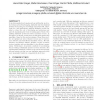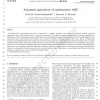396 search results - page 48 / 80 » How scientific models can explain |
NIPS
2007
13 years 9 months ago
2007
Reward-modulated spike-timing-dependent plasticity (STDP) has recently emerged as a candidate for a learning rule that could explain how local learning rules at single synapses su...
CIDR
2009
13 years 8 months ago
2009
Recent excitement in the database community surrounding new applications--analytic, scientific, graph, geospatial, etc.--has led to an explosion in research on database storage sy...
ATAL
2010
Springer
13 years 8 months ago
2010
Springer
This paper deals with fair assignment problems in decision contexts involving multiple agents. In such problems, each agent has its own evaluation of costs and we want to find a f...
SIGMOD
2003
ACM
14 years 7 months ago
2003
ACM
In modern application domains such as multimedia, molecular biology and medical imaging, similarity search in database systems is becoming an increasingly important task. Especial...
EAAI
2007
13 years 7 months ago
2007
Explaining how engineering devices work is important to students, engineers, and operators. In general, machine generated explanations have been produced from a particular perspec...


